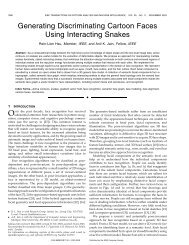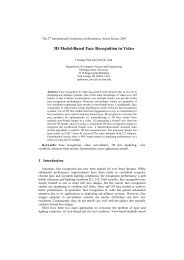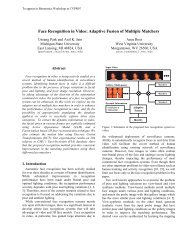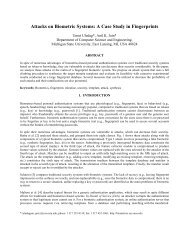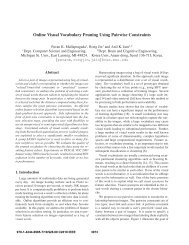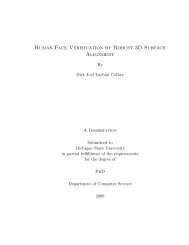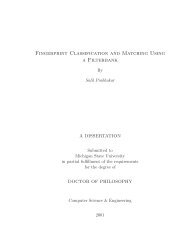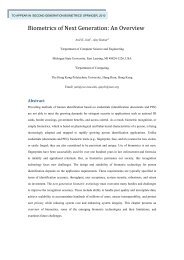Face Detection and Modeling for Recognition - Biometrics Research ...
Face Detection and Modeling for Recognition - Biometrics Research ...
Face Detection and Modeling for Recognition - Biometrics Research ...
You also want an ePaper? Increase the reach of your titles
YUMPU automatically turns print PDFs into web optimized ePapers that Google loves.
E comp<br />
eye = E msat + E csh + E cdif , (5.12)<br />
(<br />
E msat = [ (R − K 3 )2 + (G − K 3 )2 + (B − K 3 )2<br />
) 0.5<br />
(R + G + B − K)2<br />
− ],<br />
3<br />
(5.13)<br />
E csh = [[Cr − K/2] 2 − [Cb − K/2] 2 ], (5.14)<br />
E cdif = [[Cr] − [Cb]], (5.15)<br />
where E msat is the modified saturation (that is the distance in the plane between<br />
a point (R, G, B) <strong>and</strong> (K/3, K/3, K/3)) where R + G + B = K, E csh<br />
is chroma<br />
shift, E cdif is chroma difference, K = 256 is the number of grayscales <strong>for</strong> each color<br />
component, <strong>and</strong> [x] indicates a function that normalizes x into the interval [0, 1]. The<br />
eye component energies <strong>for</strong> subjects in Fig. 5.11(a) is shown in Fig. 5.11(b). The<br />
(a) (b) (c) (d) (e)<br />
Figure 5.11. Component energy (darker pixels have stronger energy): (a) face region<br />
of interest; (b) eye component energy; (c) mouth component energy; (d) nose<br />
boundary energy; (e) nose boundary energy shown as a 3D mesh surface.<br />
mouth component energy is computed as E comp<br />
mouth<br />
126<br />
= [−[Cb] − [Cr]]. Figure 5.11(c)



